
"What the fuck is an avali?", several have asked,
probably because of our Co-Owner, My Boyfriend, Treble Sharp.




That is an Avali.
But you knew that much.
In short, Avali are a fictional race of aliens. If you wish to know more, read on.
To help me explain more about them, I'm gonna steal a bunch of content from the The Official Avali Wiki. Because I'm too lazy to think of a way to word it myself.
those who prefer a brief introduction; if the Avali were to be summarized in a single barrage of adjectives it would be: "four-earred, diminutive, post-singularity, fluffy, nomadic, avian, space-raptor hunters/singers"
For those who prefer a longer approach: the Avali are nomadic pack hunters from an iceball world far outside the goldilocks zone of their local star. As such, they evolved with more of a focus on sound than eyesight, have 4 very sensitive ears and, unsurprisingly, a culture that values sound and music more than visual arts. Since being uplifted by another species (albeit accidentally, their former "benefactors" did eventually try to wipe them out), they are now teetering on the brink of technological singularity, and so display a paradoxical mixture of high-technology and nomadic tribal culture.
The symbol of the Avali
Avali Biology
Unlike humans, the Avali rely on liquid ammonia as the primary solvent in their biology. It is important to note that the Avali are still carbon-based organisms; their systems merely use liquid ammonia instead of water.
The boiling point of ammonia under standard pressure is -33 Celsius. In theory, this means any creature with ammonia as a major component of its blood would embolize when exposed to higher temperatures causing incapacitation and death by the formation of gaseous bubbles in the bloodstream.

This unique biology had a number of advantageous side-effects once the Avali became spacefaring. On other worlds they can survive naked for an extended period of time in temperatures approaching or even exceeding zero Celsius (assuming normal earth atmospheric pressure), provided they have a supply of methane to breathe. With relatively simple coolant underlays fitted in their clothes or with thermal regulator survival implants, they can survive near-indefinitely on a reasonably wide range of worlds.
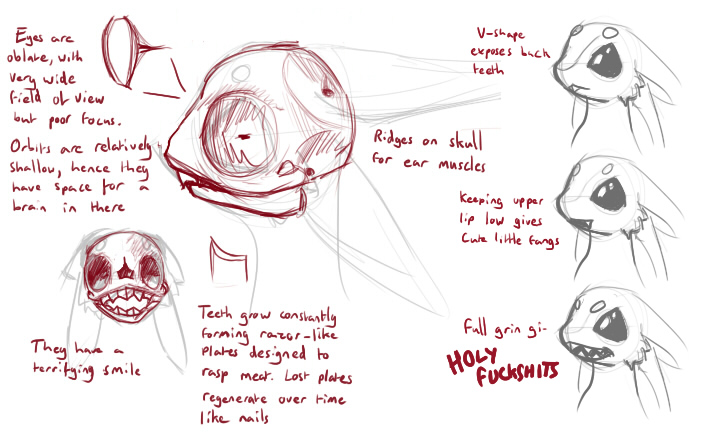
Avali are not mammals, but instead more similar to prehistoric Earth dromaeosauridae. Avali blood is pale violet in color, a tint evident in their open mouths, bare skin, and other soft tissues. Male and females are most easily told apart by their feathers, as there are no other external differences. Females tend to have muted, two-tone feathers, often with speckled patterns, while males have brightly colored, iridescent bands across much of their body.
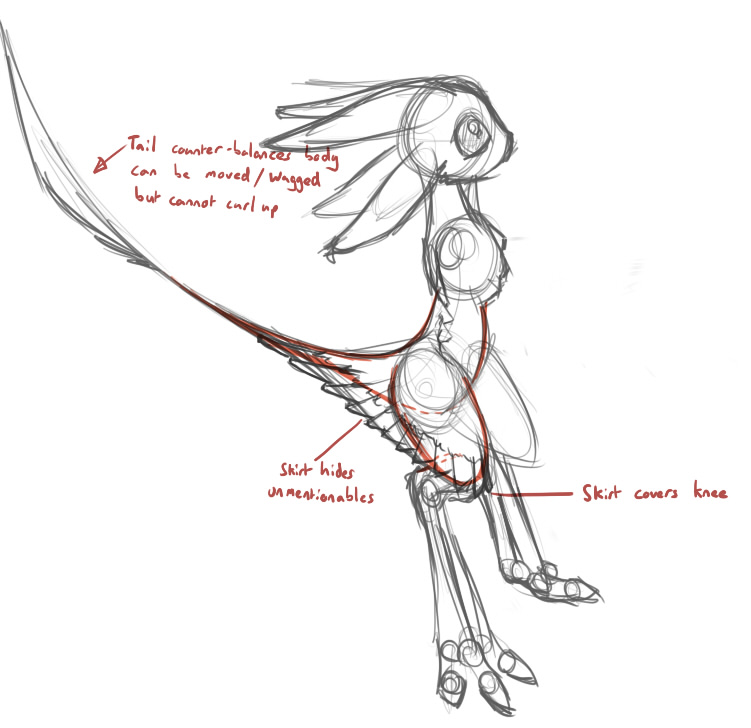
The Avali are superficially similar to dromaeosauridae of ancient Terra. They stand around 1 to 1.2 meters tall upright, around 1.5 to 1.8 meters from nose to tail tip, and are covered in a thick layer of insulating feathers. Their wing feathers allow them to glide extensively and even fly to some extent on their homeworld of Avalon, but are far less useful on higher-gravity worlds. Avali on other planets are often only able to make controlled glides and break falls on their own, and cannot truly fly unaided.
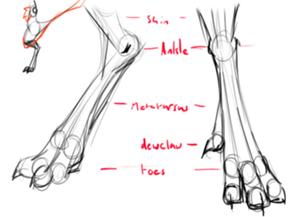
Similarly to Earth birds, the Avali possess an entire range of specialized feathers: their upper body has slicker and oilier feathers to protect from dry and abrasive snowstorms, while their lower body has lighter, fluffier down feathers that help to insulate the core body. They also possess pulviplumes, specialized down feathers that regenerate continuously. The outer barbules break off and help to oil and powder the other feathers, keeping them in pristine condition. This same "powdering" mechanism has the interesting effect of also treating and preserving fur, making fur hide a popular clothing lining.
Avali Technology
Spacecraft & Aircraft
Avali design emphasizes speed, stealth, striking power, and battlefield awareness at the expense of armor and redundant systems. Avali vehicle combat strategy in general emphasizes rapid, unexpected attacks followed by swift retreats to keep the strike force out of the line of fire. As an extension of this line of military thought, Avali combat vehicles usually mount powerful long-range railguns and are designed for use alongside extensive drone support and work as command relays for these unmanned battlefield networks.
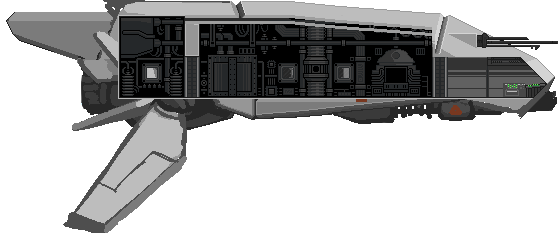
Drones
The Avali make extensive use of remotely-controlled drones, for military, exploratory, medical, and utility purposes. The majority of drones are small and lightweight, using rotors to hover some distance off of the ground. Whether or not the Avali make use of heavier drones in the form of unmanned space, air, or land vehicles remains unconfirmed
.

Ranged Weaponry
The Avali have long since passed the days of fiddling with jacketed bullets and propellant, and now typically rely on railguns as their primary method of dispensing death at range. In brief, railguns work by applying a charge to two parallel rails that passes through the round, creating electromagnetic forces that rapidly accelerate the round down the rails. Railgun weaponry lacks many of the restrictions on efficiency suffered by propellant-based firearms and works well at a wide variety of scales.
Melee Weaponry
While the Avali military typically shies away from melee combat, their melee weapons technology is no less formidable and still sees frequent use by colonists in self defense. In order to make travel easier, when they do require a melee weapon they use self-forging vibro-blades which are extremely light and portable, often being little more than a hilt until activated.
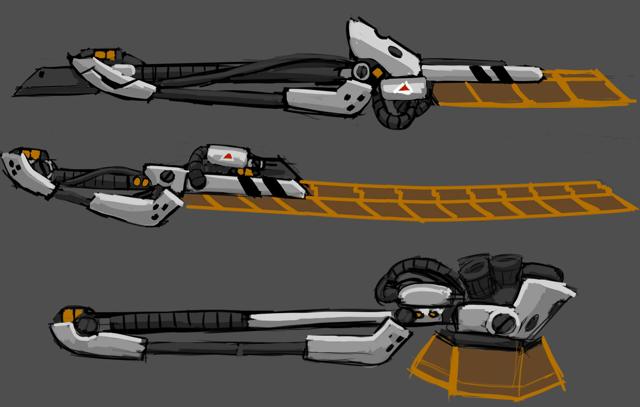
These "aerotech" weapons are essentially compact nanoprinters; the weapon rapidly forges an ultra-lightweight crystalline compound similar to aerogel, which is then pushed outwards along a rail that carries it away from the print head to be used as a blade or weapon. The cutting action is assisted by a sonic occilator in the rail, which causes the blade to behave like a nanoscale chainsaw, cutting with an imperceptible sawing motion as long as the edge remains in contact to the victim. This cutting action is in fact required to comepnsate for the blade's low mass and the resulting lack of heft when swung compared to a conventional bladed weapon.
The material that composes the blade is is not especially strong, but carries a sharp edge. When it strikes a target, the material tends to break up and shear away exposing a fresh, even sharper surface below, ensuring that the otherwise fragile blade remains razor-sharp throughout the stroke.This process damages the blade very quickly, but lines of weakness are included in the structure like a box cutter, allowing older blade sections to snap off and fresh sections to be extruded.

These same lines of weakness make it possible for the operator to twist the blade sharply within a wound, causing it to shatter and leave long, razor-like shards inside the victim. Such wounds often cause intense blood loss and are very difficult to treat.
Armor & Gear
The Avali have access to powered exoskeletons and use them in a variety of military and civilian occupations, either for caution’s sake or to provide additional strength and mobility. Such suits are usually coupled with hazardous environment (HEV) mechanisms to allow safe use in a wide variety of situations and employments. Completely-sealed extra-vehicular activity (EVA) suits also exist, but often require the operator to pluck his or her long wing feathers before use.

An Avali Helmet
Augmentation
Virtually all Avali citizens have some degree of augmentation, even if only a neural jack and medical “Guardian” nanites.
The so-called "Guardian" nanites are the single most common augmentation, found in almost the entire population. They are a composed of several strains of small, self-replicating medical nanites that remain in the user's tissues and bloodstream, working to destroy pathogens, to detect and isolate early-stage cancers, and to repair minor injuries or stabilize more major traumas. While the “Guardian” nanites are not themselves capable of computational power, they are monitored locally by a medical chip that is frequently updated during routine checkups.
The Nexus
The Nexus is a powerful interstellar network of computers, systems, and information all enabled and networked through the use of the unique properties of the valuable sync crystals . The Nexus is accessed through neural jacks, augments installed in the brains of nearly all Avali citizens. Citizens use the Nexus nearly constantly, either through “augmented reality” (virtual projections upon the real world) or fully-fledged virtual reality simulations. Users represent themselves on the Nexus with a variety of avatars, some more or less realistic to their true forms, designed for a variety of different functions.
Full-fledged browsing of the Nexus can be most closely compared to using the modern-day internet. Unlike seeing the internet as a series of pages, however, users of the Nexus experience sites on the Nexus as virtual locations. As a virtual landscape, however, the Nexus is not constrained by normal laws of transportation and motion. Illusions such as three-dimensional space and movement are just that in the Nexus: illusions. Users do not have to ‘walk’ between locations on the Nexus (though many sites may chose to represent motion as such for ease of use) and some of the more adaptable web locations on the Nexus would probably be set up so that information comes to the user when desired, rather than the user coming toward the information. Jumping between locations on the Nexus is really as simple as that; a user must merely choose another location to be whisked away. Information gathering and processing is one of the most basic functionalities available through the Nexus, and one of the primary uses of augmented reality systems. The Nexus provides citizens with the ability to display information on objects, people, their environment, specific dates, complex mathematic formulae, and nearly anything else included in the Nexus’ unfathomably vast network. Not only can the Nexus display raw information, but it is also capable of projecting step-by-step directions and three-dimensional schematics to users. This is incredibly useful to Avali trying to learn new and difficult tasks, or to specialists like architects and engineers.
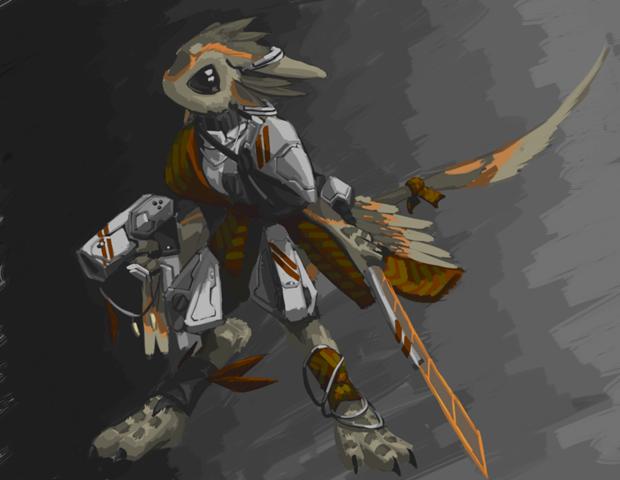
Avali hunter concept art
History of the Avali Concept
The Avali began life as an exercise in imagination as to how differences from humanity in an alien civilization would lead them to develop in different ways than are familiar, and cause them to form a completely different picture of their universe.
The Avali were made their first public appearance as a race created in the hit game Spore, where they were accidentally given their scientific designation, the “Iubati” (ee-you-bah-ti). Though already recognizable as what would eventually become the Avali, the concept was not completely finished and continued to develop over the years. Despite the handful of changes since, their appearance in Spore set the basic shape of Avali physiology and culture, and additionally provided a first glimpse into the dangers lurking at the edge of Avali civilization.
Some years later the Avali returned in the form of a modification for the indie game Starbound. The race had continued to undergo development over the interim period between Spore and Starbound, and the results were the Avali featured in the modification today. The Avali have since become a major part of the Starbound modding community, featuring in several other add-on modifications, such as Catalina Industries Incorporated and the Racial Crossover Mod.
About the Creator
Though he prefers to remain unidentified personally, alias “RyuujinZERO” (or just “Ryuujin”, depending on the forum), is the solitary and long-time creator and developer of the Avali. Possessing an inquisitive mind and a keen grasp of a variety of sciences, RyuujinZERO has turned development of the Avali modification for Starbound into a part-time hobby. RyuujinZERO is from the United Kingdom and comes from a background in the natural sciences. He has an extensive history in modding, and his past projects have included modifications for Neverwinter Nights, Oblivion, Skyrim, Fallout 3 and Freelancer. However, the Avali Race Mod for Starbound represents his first foray into pixel-based spriting.
back to the MOTD